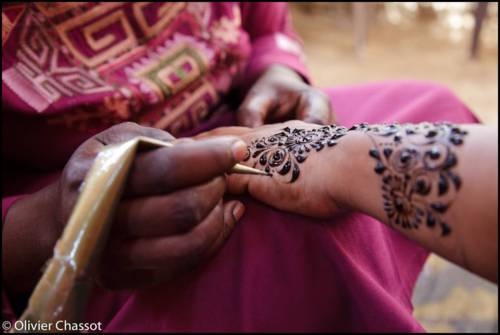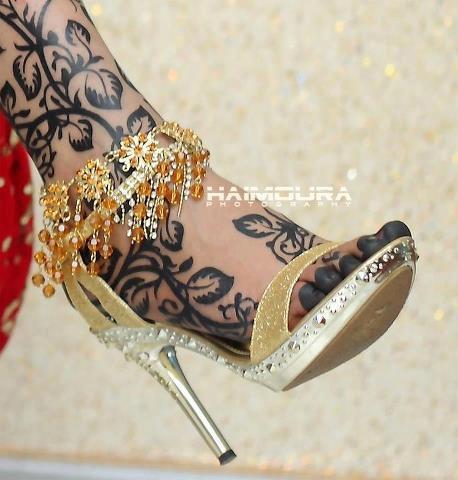Source(google.com.pk)
Sudanese Henna Designs Biography
The ancient art of Mehndi is widely used in traditional and cultural events since its evolution for Decorating Hand & Feet.Different part of World Use Various Techniques to decorate Body parts with Mehndi.Many use Electronic technique to fetch tattoos on body or other use Mehndi patterns to save time and other use paint by cones.Mehndi Art is Famous in Nepal, India, Pakistan, Bangladesh, Sudan or other Muslim countries but now even popular in United States.
Mehndi Art exist since 12th century and its believed that Arabic people brought Henna art in India and Asian countries.Mehndi Symbolize fertility and people use Mehndi paste to decorate Hands and Feet.Apart from traditional significance, Henna is also use for its cooling therapeutic effect.The art is now turning into business and Mehndi Designers now call as Mehndi artist and so today She-styles brings gorgeous and beautiful Arabic Mehndi designs to promote Mehndi Art.
On a broad basis there are two kinds of Mehndi Designs,Arabic and Indian.Indian Designs are more intricate consists on fine work and fills your entire palm.Indian patterns are Peacock, musical instruments,
Mangoes, Flower and most common figures are part of Indian Mehndi Patterns.Bridal Indian Mehndi design extends up-to the Elbow or even higher to shoulder and no part of hand left blank.
Arabic designs are Bolder and there is not much intricacy and drawn in large outlines and iner space is filled with lines and dots.Flowers, Paisley pattern, are most common in Arabic Mehndi.Arabic design not cover entire hand and some part of the hands left blank and blank space highlight the bold Mehndi Designs which is the beauty of Arabic art. and mostly girls apply Arabic Mehndi for festival or functions.Lets Check out the Indo-Arabic or Captivating Mehndi Designs.
When I first saw the title of Original Music’s 1995 release, Rain in the Hills, I assumed it would be a compilation of Rwandan or Congolese music, places I most associate with forest-filled, hilly landscapes. It came as a nice surprise when my earphones were filled with a very different sound: music by the Beja people who live in the hills of North-Eastern Sudan, in and around the city of Port Sudan.
The album was recorded by John Low who lived in this drought-prone area while he was working for Oxfam in the early 90s. As he says in the liner notes, you can sometimes hear street noise or people chatting at Oxfam parties in the background on the recordings. If anything, however, this gives the album an authentic feel as if you, too, were sitting in a steamy Sudanese apartment, chatting with Beja musicians.
The songs on Rain in the Hills are sung in the Beja language and in Arabic. Some sound distinctly Arabic/Yemeni while others have a more East African sound. It’s definitely new to my ears. The liner notes even claim that, as far as John Low is aware, the music on this disc is unknown outside of the Sudan and southern Egypt.
Until recently the Beja used only one instrument in their music, the basankob. In recent years the oud has been introduced, as you’ll hear today, since it has a greater musical range.
Great tracks like Days and Nights make me realize how much I have yet to discover in East Africa…
ps- Cheers to Gabriel who picked me out of the crowd at the Rajery show last night. Always nice meeting Benn loxo people in person.
pps- thanks again to Andrew for the music.
Musa Adem – Days and Nights
Mohamed Badri Hassan – Rain In The Hills
Many of you probably have Emmanuel Jal and Abdel Gadir Salim’s album Ceasefire already but I haven’t yet posted it on Benn loxo.
Nominated for the 2006 BBC World Music Awards, Emmanuel Jal has risen from obscurity to become one of Africa’s most well-known rappers.
He’s a good musician in his own right, but Jal’s life story makes journalists drool. He was a child-soldier in Sudan from a young age until was smuggled into Kenya by a British aid worker. In Nairobi, Jal flourished as a musician despite the aid worker dying in a car crash. He eventually started giving concerts for homeless kids as well as participating in the local hiphop scene as an MC.
For 2005′s Ceasefire Jal collaborated with Sudanese oud-playing legend, Abdel Gadir Salim. Jal raps and sings in English, Arabic, Swahili and Dinka while Salim strums it out, occasionally busting in with his own vocals. The combination of old-shcool and new-school East African sounds works really well. It’s no surprise that this album has become a success, with or without the “media-friendly-so-now” Jal bio.
You can pick up Ceasefire over at the World Music Network or at any good record shop. You might have heard Jal on the latest War Child/Help compilation, too.
ps- there won’t be any new posts until the beginning of October. Time for some time in the sun, you know.










Sudanese Henna Designs Biography
The ancient art of Mehndi is widely used in traditional and cultural events since its evolution for Decorating Hand & Feet.Different part of World Use Various Techniques to decorate Body parts with Mehndi.Many use Electronic technique to fetch tattoos on body or other use Mehndi patterns to save time and other use paint by cones.Mehndi Art is Famous in Nepal, India, Pakistan, Bangladesh, Sudan or other Muslim countries but now even popular in United States.
Mehndi Art exist since 12th century and its believed that Arabic people brought Henna art in India and Asian countries.Mehndi Symbolize fertility and people use Mehndi paste to decorate Hands and Feet.Apart from traditional significance, Henna is also use for its cooling therapeutic effect.The art is now turning into business and Mehndi Designers now call as Mehndi artist and so today She-styles brings gorgeous and beautiful Arabic Mehndi designs to promote Mehndi Art.
On a broad basis there are two kinds of Mehndi Designs,Arabic and Indian.Indian Designs are more intricate consists on fine work and fills your entire palm.Indian patterns are Peacock, musical instruments,
Mangoes, Flower and most common figures are part of Indian Mehndi Patterns.Bridal Indian Mehndi design extends up-to the Elbow or even higher to shoulder and no part of hand left blank.
Arabic designs are Bolder and there is not much intricacy and drawn in large outlines and iner space is filled with lines and dots.Flowers, Paisley pattern, are most common in Arabic Mehndi.Arabic design not cover entire hand and some part of the hands left blank and blank space highlight the bold Mehndi Designs which is the beauty of Arabic art. and mostly girls apply Arabic Mehndi for festival or functions.Lets Check out the Indo-Arabic or Captivating Mehndi Designs.
When I first saw the title of Original Music’s 1995 release, Rain in the Hills, I assumed it would be a compilation of Rwandan or Congolese music, places I most associate with forest-filled, hilly landscapes. It came as a nice surprise when my earphones were filled with a very different sound: music by the Beja people who live in the hills of North-Eastern Sudan, in and around the city of Port Sudan.
The album was recorded by John Low who lived in this drought-prone area while he was working for Oxfam in the early 90s. As he says in the liner notes, you can sometimes hear street noise or people chatting at Oxfam parties in the background on the recordings. If anything, however, this gives the album an authentic feel as if you, too, were sitting in a steamy Sudanese apartment, chatting with Beja musicians.
The songs on Rain in the Hills are sung in the Beja language and in Arabic. Some sound distinctly Arabic/Yemeni while others have a more East African sound. It’s definitely new to my ears. The liner notes even claim that, as far as John Low is aware, the music on this disc is unknown outside of the Sudan and southern Egypt.
Until recently the Beja used only one instrument in their music, the basankob. In recent years the oud has been introduced, as you’ll hear today, since it has a greater musical range.
Great tracks like Days and Nights make me realize how much I have yet to discover in East Africa…
ps- Cheers to Gabriel who picked me out of the crowd at the Rajery show last night. Always nice meeting Benn loxo people in person.
pps- thanks again to Andrew for the music.
Musa Adem – Days and Nights
Mohamed Badri Hassan – Rain In The Hills
Many of you probably have Emmanuel Jal and Abdel Gadir Salim’s album Ceasefire already but I haven’t yet posted it on Benn loxo.
Nominated for the 2006 BBC World Music Awards, Emmanuel Jal has risen from obscurity to become one of Africa’s most well-known rappers.
He’s a good musician in his own right, but Jal’s life story makes journalists drool. He was a child-soldier in Sudan from a young age until was smuggled into Kenya by a British aid worker. In Nairobi, Jal flourished as a musician despite the aid worker dying in a car crash. He eventually started giving concerts for homeless kids as well as participating in the local hiphop scene as an MC.
For 2005′s Ceasefire Jal collaborated with Sudanese oud-playing legend, Abdel Gadir Salim. Jal raps and sings in English, Arabic, Swahili and Dinka while Salim strums it out, occasionally busting in with his own vocals. The combination of old-shcool and new-school East African sounds works really well. It’s no surprise that this album has become a success, with or without the “media-friendly-so-now” Jal bio.
You can pick up Ceasefire over at the World Music Network or at any good record shop. You might have heard Jal on the latest War Child/Help compilation, too.
ps- there won’t be any new posts until the beginning of October. Time for some time in the sun, you know.
Sudanese Henna Designs Henna Tattoo Indian Arabic Design Pictures Pics Images

Sudanese Henna Designs Henna Tattoo Indian Arabic Design Pictures Pics Images

Sudanese Henna Designs Henna Tattoo Indian Arabic Design Pictures Pics Images

Sudanese Henna Designs Henna Tattoo Indian Arabic Design Pictures Pics Images

Sudanese Henna Designs Henna Tattoo Indian Arabic Design Pictures Pics Images

Sudanese Henna Designs Henna Tattoo Indian Arabic Design Pictures Pics Images

Sudanese Henna Designs Henna Tattoo Indian Arabic Design Pictures Pics Images

Sudanese Henna Designs Henna Tattoo Indian Arabic Design Pictures Pics Images

Sudanese Henna Designs Henna Tattoo Indian Arabic Design Pictures Pics Images

Sudanese Henna Designs Henna Tattoo Indian Arabic Design Pictures Pics Images

Sudanese Henna Designs Henna Tattoo Indian Arabic Design Pictures Pics Images
No comments:
Post a Comment